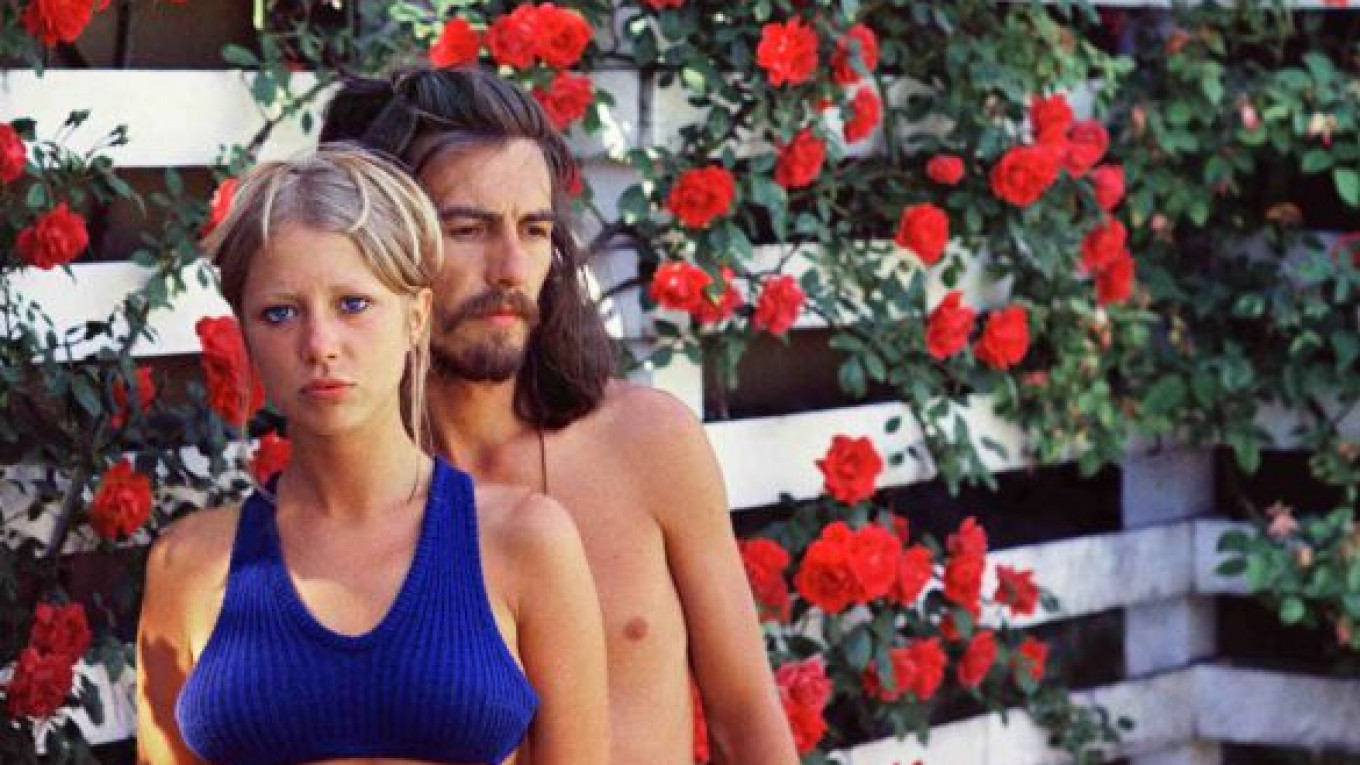Many women would swoon at the idea of taking photographs with the guitar-god likes of George Harrison and Eric Clapton, but for ’60s it-girl Pattie Boyd, this was real life — she’s been married to both of them.
The photographer, former model and self-described muse of two iconic musicians came to Moscow last week for the opening of “Pattie Boyd: The Beloved of Rock ’n’ Roll,” an open-air exhibit of photographs she took during her relationships with Clapton and The Beatles.
“I definitely prefer to be behind the lens because then I’m in control,” said Boyd, now 67, who has graced several covers of Vogue and reportedly inspired Twiggy.
The 28-image exhibit, which opened within the framework of the Jaguar Summer Museum, transforms a series of free-standing billboard booths on the pedestrian street Stoleshnikov Pereulok into a mini retrospective of Boyd’s personal experience of the swinging ’60s.
What began as a simple photography hobby turned out to be a “hidden passion,” Boyd said, after a friend approached her about displaying some of the old photographs she had boxed up at home. The result was “Through the Eyes of a Muse,” a 2005 exhibit at the San Francisco Art Exchange that went on to show in Ireland, Australia, Canada and Kazakhstan.
“It was really exciting when I discovered these photographs and realized some of them were quite good,” Boyd said. “My favorite image is of George walking up a snowy hill. I had just called him, and I snapped the picture as he turned around to look at me.”
The current display includes candid images from Boyd’s time with Harrison and Clapton, snapshots of rock star friends — including Rolling Stones guitarist Ronnie Wood and Jaguar-
collecting guitarist Jeff Beck — and haphazard photographs from her recent travels. The images are accompanied by excerpts from her 2007 autobiography, “Wonderful Tonight: George Harrison, Eric Clapton, and Me.” These are often more engaging than the photos. One quote reveals that Frank Sinatra considered the song “Something,” which Harrison wrote for Boyd, to be the best love song ever written.
When asked what it truly means to be a muse, Boyd replied: “Throughout history there have been many muses. I was just lucky to be in the right place at the right time.”
Boyd was only 19 years old when she met The Beatles during the filming of “A Hard Day’s Night,” in which she was cast as a doting schoolgirl. In her memoir, she describes Harrison as “the best-looking man I’d ever seen,” though she initially turned down his invitations to dinner out of loyalty to an unloved boyfriend. The couple was married two years later, but separated in 1977. Soon after, Boyd married Harrison’s close friend Clapton, who wrote the songs “Layla” and “Wonderful Tonight” in her honor. The two musicians remained on good terms, but Clapton’s marriage began to unwind; his heavy alcoholism eventually caused Boyd to leave him.
Boyd’s photographs disclose none of the personal dramas, whirlwind lifestyle and overwhelming publicity that punctuated her relationships. Their value lies solely in the fact that they capture intimate glimpses of personalities who, to the rest of us, remained completely inaccessible.
Perhaps her most laudable photograph shows The Beatles and friends seated around the Maharishi Mahesh Yogi, the spiritual leader who later became the band’s guru after they met him on a trip to India that Boyd initiated. Among the snapshot’s expressive faces are a skeptical Paul, an intrigued George and a wide-eyed, almost mesmerized John. This meaningful moment anticipates the deep currents of Indian philosophy that would later seep into The Beatles’ musical style and strongly influence — indeed, transform — Lennon and Harrison’s lives.
Back in the U.S.S.R, The Beatles long symbolized the forbidden freedoms associated with the West. Boyd hopes that today’s audience, when viewing her photographs, will simply share her feelings of nostalgia.
“I hope they’ll look at them and enjoy them,” she said, “and remember the music that made them happy.”
“Pattie Boyd: The Beloved of Rock ’n’ Roll” runs till Sept. 3 on Stoleshnikov Pereulok. Metro Teatralnaya.
A Message from The Moscow Times:
Dear readers,
We are facing unprecedented challenges. Russia's Prosecutor General's Office has designated The Moscow Times as an "undesirable" organization, criminalizing our work and putting our staff at risk of prosecution. This follows our earlier unjust labeling as a "foreign agent."
These actions are direct attempts to silence independent journalism in Russia. The authorities claim our work "discredits the decisions of the Russian leadership." We see things differently: we strive to provide accurate, unbiased reporting on Russia.
We, the journalists of The Moscow Times, refuse to be silenced. But to continue our work, we need your help.
Your support, no matter how small, makes a world of difference. If you can, please support us monthly starting from just $2. It's quick to set up, and every contribution makes a significant impact.
By supporting The Moscow Times, you're defending open, independent journalism in the face of repression. Thank you for standing with us.
Remind me later.


